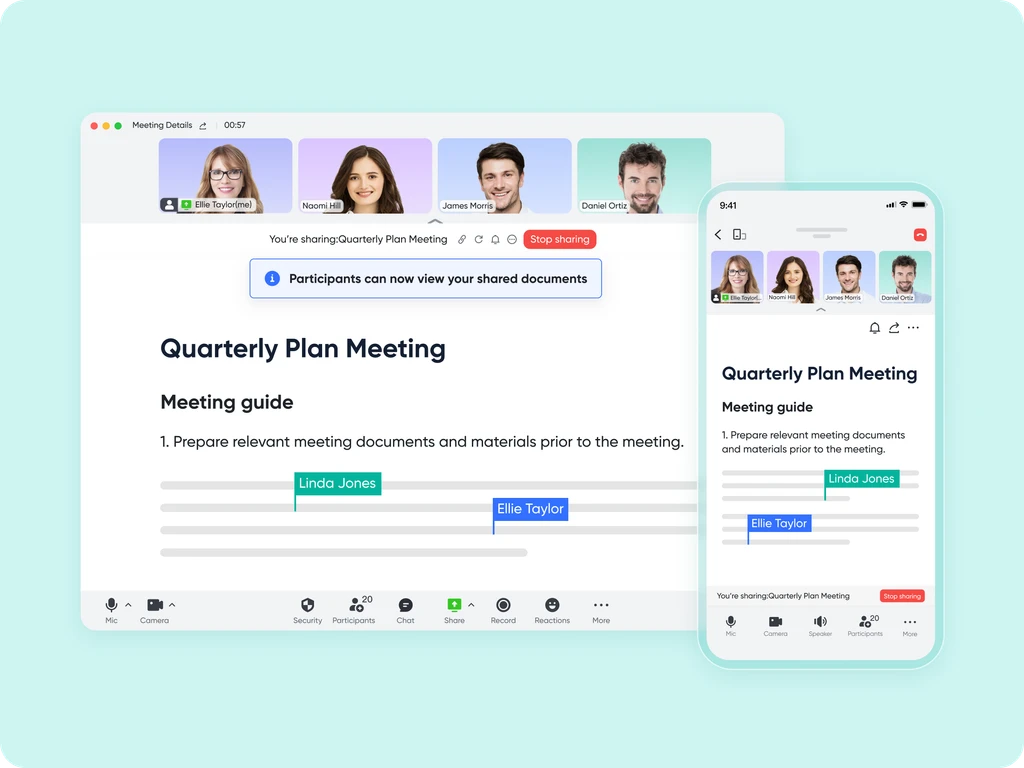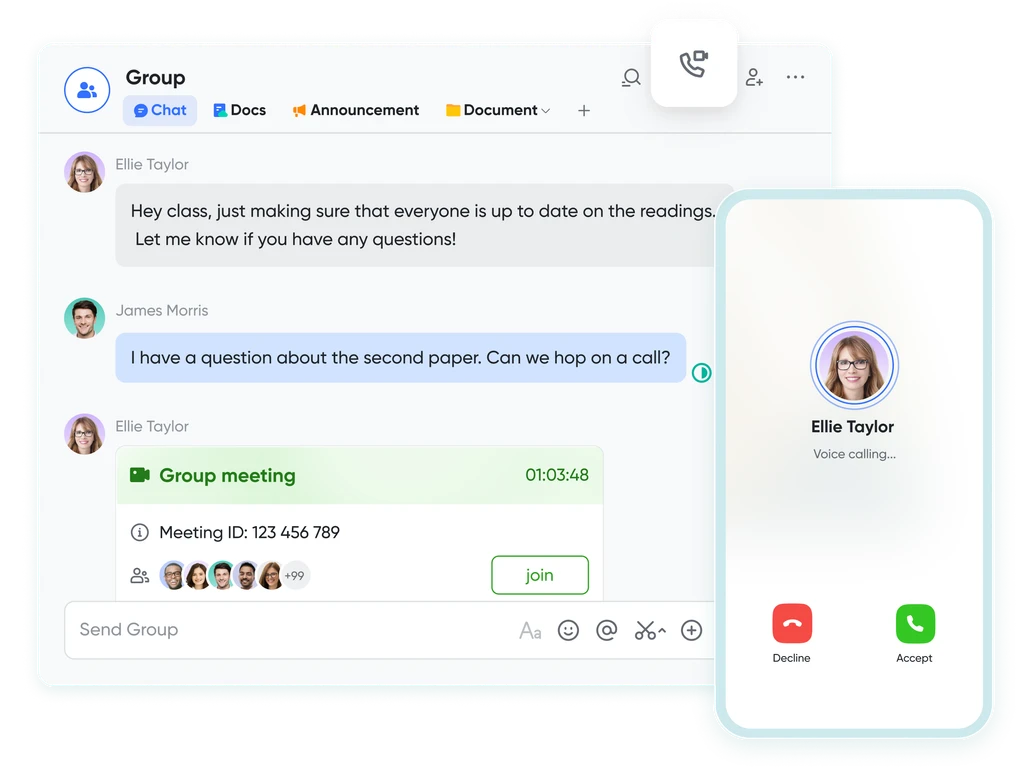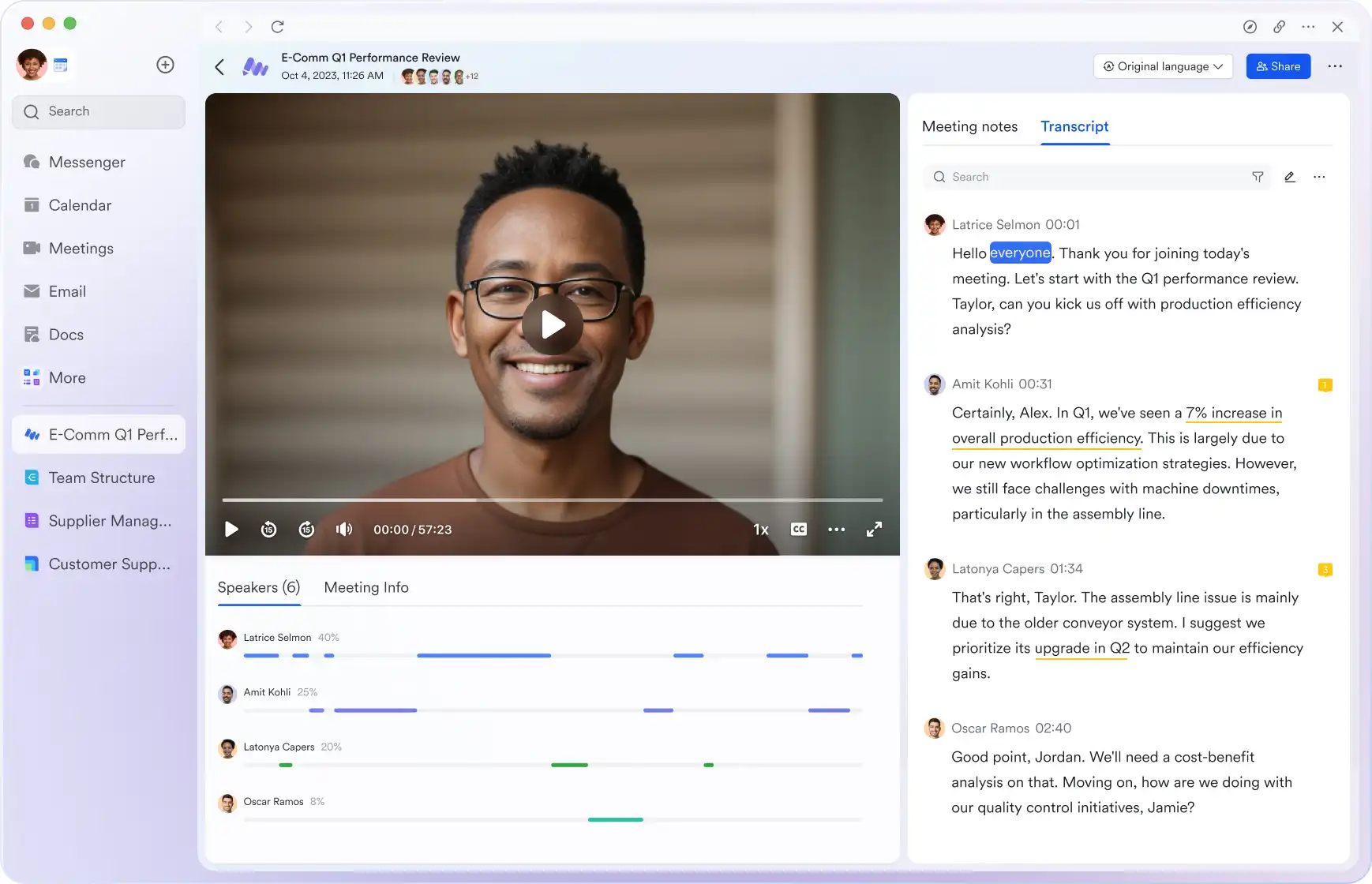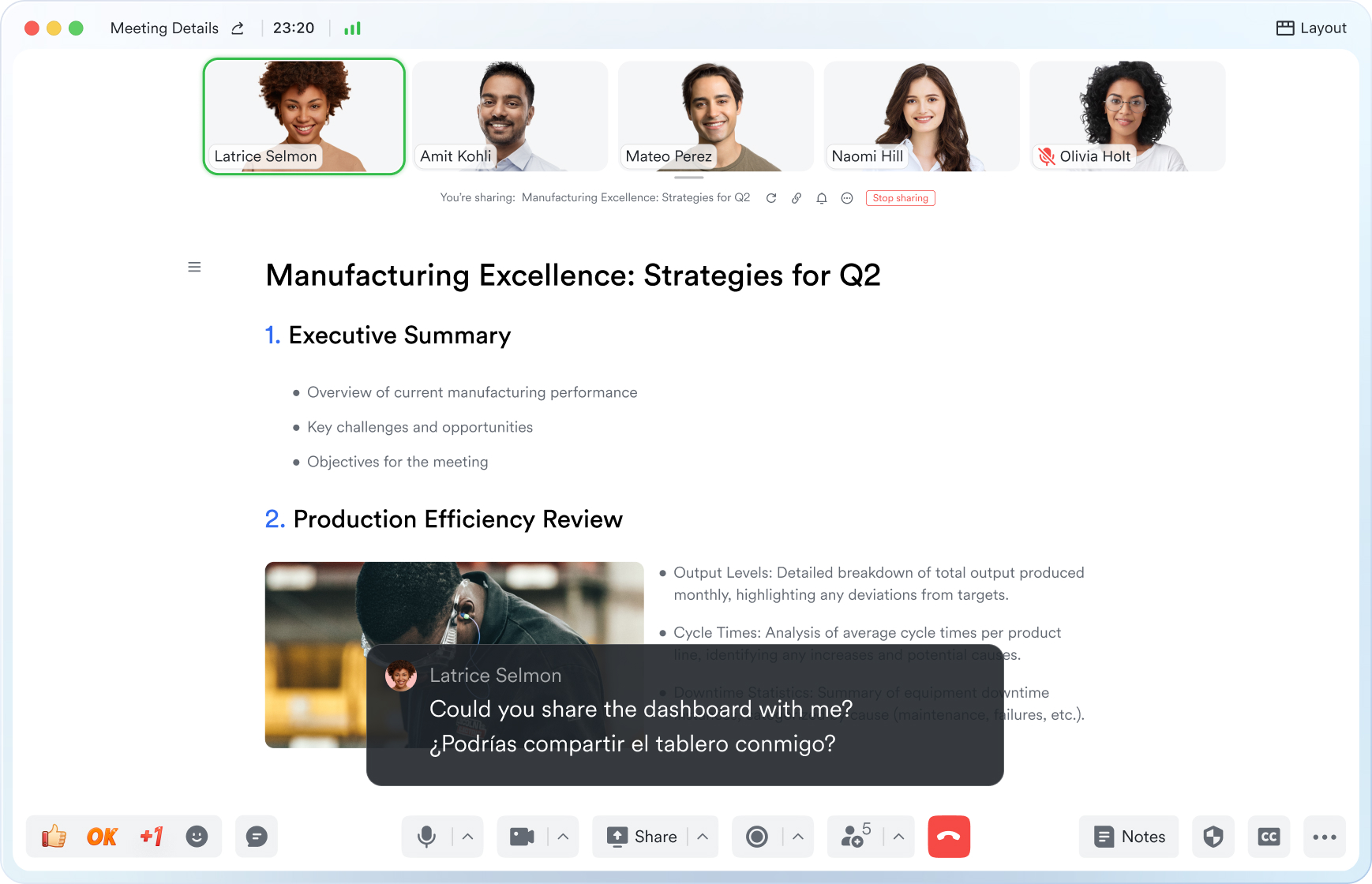Okr Meeting
This guide will walk you through the essential elements of use okr meeting to keep your attendees aligned and engaged.
Try Lark for Free
In the fast-paced business landscape of 2024, the successful execution of Objectives and Key Results (OKR) meetings is pivotal to achieving organizational goals and staying competitive. In this comprehensive guide, we will delve into the intricacies of hosting and managing effective OKR meetings. Whether you're a seasoned professional or new to OKRs, this article will equip you with the knowledge and strategies needed for a successful OKR meeting in 2024.
Use Lark Meetings to turn meetings into true collaborative experiences.
What is an okr meeting?
Defining OKR Meetings
OKR meetings, short for Objectives and Key Results meetings, are structured gatherings where teams and stakeholders come together to review progress towards their objectives and discuss key results. These meetings serve as a crucial checkpoint to ensure alignment with the organization's overarching goals.
Goals of an okr meeting
Alignment and Accountability
The primary goals of an OKR meeting include:
- Alignment: Ensuring that team objectives are aligned with the company's strategic goals.
- Accountability: Holding team members responsible for their respective key results.
Who should attend an okr meeting?
Key Participants
For a successful OKR meeting, it's essential to have the right individuals in attendance:
- Team Members: Those responsible for executing objectives.
- Managers: To provide guidance and support.
- Stakeholders: Including executives or investors, depending on the context.
Related:
Unlock the Power of Webinars: A Comprehensive Guide to Boost Your Business | Lark Blog | Lark BlogLearn more about Lark x Meetings
Topics, agenda, and structure of an okr meeting
Structuring the Meeting
A typical OKR meeting agenda consists of the following key components:
- Objective Review: Discuss progress towards achieving objectives.
- Key Result Updates: Evaluate the status of key results.
- Obstacles and Solutions: Identify challenges and brainstorm solutions.
- Action Items: Assign tasks and responsibilities for the upcoming period.
- OKR Scoring: Review and assess the performance of key results.
How to host an okr meeting?
Step-by-Step Guide
Hosting a successful OKR meeting involves meticulous planning and execution. Follow these steps for optimal results:
- Preparation: Collect and distribute necessary materials, including current OKRs and performance data.
- Facilitation: Appoint a skilled facilitator to guide the meeting and keep it on track.
- Engagement: Encourage active participation and contributions from all attendees.
- Time Management: Allocate specific time slots for each agenda item to prevent overruns.
- Follow-Up: Ensure that action items and commitments are documented and followed through after the meeting.
Related:
Master the Art of Meeting Notes with Lark for Enhanced Collaboration | Lark Blog | Lark BlogLearn more about Lark x Meetings
How often does an okr meeting occur?
Meeting Frequency
The frequency of OKR meetings can vary based on the organization's needs:
- Quarterly: Common for organizations with quarterly OKR cycles.
- Monthly: Suitable for more frequent performance evaluations.
- Weekly: Ideal for fast-paced, agile teams.
Key differences between okr meetings and similar meetings
Understanding Distinctions
OKR meetings have unique characteristics that set them apart from other types of gatherings:
- OKR Focus: Unlike status meetings, OKR meetings primarily focus on goal achievement.
- Data-Driven: They rely on data and metrics to assess progress.
- Accountability: OKR meetings emphasize individual and team accountability.
Learn more about Lark x Meetings
Common pitfalls of okr meetings
Avoiding Mistakes
To ensure the success of your OKR meetings, steer clear of these common pitfalls:
- Lack of Preparation: Failing to prepare adequately can lead to unproductive meetings.
- Off-Topic Discussions: Straying from the agenda can derail the meeting's purpose.
- Dominance: Allowing one person to dominate the conversation can hinder collaboration.
- Ignoring Feedback: Neglecting input and feedback from participants can hinder improvement.
- Rushing: Avoid the temptation to rush through the meeting; it's essential to cover all agenda items thoroughly.
Factors for a successful virtual okr meeting
Adapting to Remote Work
With the rise of remote work, virtual OKR meetings have become commonplace. Consider the following factors for a successful virtual OKR meeting in 2024:
- Technology: Utilize reliable video conferencing tools like Lark for seamless virtual meetings.
- Engagement: Keep remote participants engaged through interactive discussions and visual aids.
- Documentation: Maintain detailed records and share meeting minutes promptly.
Related:
Master the Art of Meeting Notes with Lark for Enhanced Collaboration | Lark Blog | Lark BlogLearn more about Lark x Meetings
Typical takeaways from an okr meeting
Measuring Success
Successful OKR meetings yield tangible takeaways:
- Clear Objectives: Team members leave with a precise understanding of their objectives.
- Actionable Insights: Identifying challenges and solutions leads to actionable improvements.
- Motivation: Achieving key results boosts team morale and motivation.
Questions to ask in an okr meeting
Driving Meaningful Discussions
To drive productive discussions during an OKR meeting, consider these questions:
- Are we on track to achieve our objectives for this quarter?
- What challenges are hindering our progress toward key results?
- What steps can we take to overcome these obstacles?
- Who is responsible for each action item, and what are the deadlines?
- How can we improve our OKR process based on our performance?
Learn more about Lark x Meetings
Examples
Real-world scenarios
Real-world scenarios
Let's explore three real-world scenarios of successful OKR meetings in various contexts:
Scenario 1: Sales Team OKR Meeting
Brief Content: In a sales team OKR meeting, the team reviewed their quarterly objectives of increasing revenue by 20%. They discussed progress on key results such as closing high-value deals and expanding their client base.
Detailed Content: The meeting began with a review of the overall sales target and the progress made in the first two months. The team celebrated their success in landing a significant client but acknowledged that they were behind on their target for high-value deals.
Scenario 2: Software Development Team OKR Meeting
Brief Content: A software development team conducted an OKR meeting to assess their progress in delivering new features. They discussed key results related to bug fixes, feature development, and user feedback.
Detailed Content: The meeting started with a demonstration of the new features developed in the past month. The team discussed the number of bugs reported and resolved, highlighting their commitment to delivering a bug-free product. They also reviewed user feedback and proposed enhancements.
Scenario 3: Marketing Team OKR Meeting
Brief Content: A marketing team gathered for their monthly OKR meeting to analyze their progress in increasing website traffic and engagement. They reviewed key results such as content publication, social media engagement, and email marketing performance.
Detailed Content: The meeting began with a review of the website traffic data, showing a steady increase over the past month. The team discussed their successful email marketing campaign and the engagement on social media platforms. They brainstormed ideas for the next month's content calendar to maintain the momentum.
Tips for do's and don'ts
Best
Practices and Pitfalls to Avoid Follow these do's and don'ts to ensure productive and effective OKR meetings:
| Do's | Don'ts |
|---|---|
| Prepare an agenda in advance. | Don't neglect preparation. |
| Encourage active participation. | Avoid going off-topic. |
| Use visual aids to illustrate goals. | Don't dominate the conversation. |
| Set clear action items and follow-ups. | Don't ignore feedback from participants. |
| Emphasize accountability. | Don't rush through the meeting. |
Learn more about Lark x Meetings
Conclusion
As we navigate the ever-evolving business landscape of 2024, mastering the art of running successful OKR meetings is essential. By understanding the fundamentals, adopting best practices, and leveraging collaborative tools like Lark, you can drive your team towards achieving their objectives and key results. Keep the principles outlined in this guide in mind, and you'll be well-prepared to lead effective OKR meetings in the years to come.
Now that you have a comprehensive understanding of OKR meetings and how to conduct them successfully, it's time to put these principles into practice and drive your team towards achieving remarkable results in 2024.
Use Lark Meetings to turn meetings into true collaborative experiences.
A Game Changer for Okr Meeting: Empower your team with Lark Meetings
In the fast-paced and dynamic world of modern business, effective communication and collaboration are crucial for success of Okr Meeting. Here we introduce Lark Meetings to serve as a centralized hub for all communication needs.
Transform your meetings into collaborative endeavors

Leverage the potency of in-call document sharing, intelligent meeting minutes, and mobile-optimized features to enhance productivity collaboratively, irrespective of your location or schedule.
Seamlessly collaborate in real-time, across any device

Share live documents instead of just screen views. Participants can navigate and edit simultaneously within the video call window, even while on the move.
Shift your focus to engagement, not note-taking

Lark Minutes automatically converts video meetings into transcripts, facilitating easy viewing, searching, and collaborative editing. Stay in the loop asynchronously, even if you can't attend the live meeting. Lark Minutes for meeting minutes support translation into 10+ different languages.
Break language barriers in communication

Lark Meetings provide real-time translation for subtitles, allowing individuals from diverse backgrounds to express themselves in their native languages. Ensure every voice is heard, regardless of geographical location. Live subtitles currently support translations from English, Chinese, and Japanese to 10+ different languages. See more translation feature in Lark.
Connect with larger audiences
Host dynamic online meetings and events accommodating up to 1,000 participants, with the flexibility of up to 50 breakout sessions for intimate group discussions within the larger meeting context. Try more Lark features for free.








